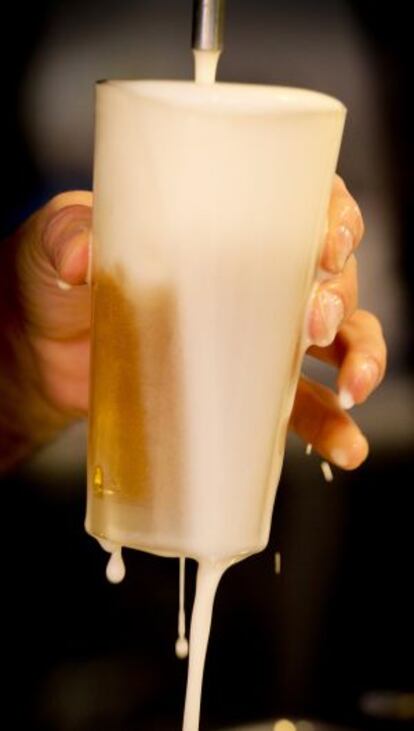Is Spain an ¡°alcoholic society¡±?
Report says social acceptance of drinking makes it difficult to educate people about abuse Spaniards¡¯ alcohol use comes in at twice the global average and higher than Europe¡¯s


Ra¨²l Rodrigo is a lifelong Real Madrid fan. But now, the 40-year-old former quantity surveyor turned barkeep has even more reason to cheer his side on. When the team loses in the Champions League, he will take around €300 in an evening, with the bar emptying within minutes of the final whistle. But when they win, he¡¯ll make more than three times that amount.
Ra¨²l¡¯s is one of around 280,000 bars throughout Spain: that¡¯s one for every 165 people, the highest ratio in the European Union. The World Health Organization (WHO) has just announced that Spain enjoys the best life-expectancy and health in the EU, but that rising alcohol consumption, along with smoking and obesity, are growing problems. The country¡¯s National Drug Plan says that alcohol use comes in at around 11.2 liters per head a year, twice the global average (6.2) and higher than Europe¡¯s (10.9). But Spain¡¯s figures also show that 31 percent of the population says it never drinks.
Beer is Spaniards¡¯ favorite tipple, which is drunk by 50 percent of the population; then spirits (28 percent), and wine (20 percent).
There are 280,000 bars throughout Spain: one for every 165 people, the highest ratio in the European Union
¡°Spain has always been an alcoholic society,¡± says Eusebio Meg¨ªas, a psychiatrist and director of the Spanish Foundation against Drug Addiction. ¡°The way we drink is different, and has more to do with diet and the Mediterranean lifestyle. But that doesn¡¯t mean we don¡¯t drink to excess. It¡¯s just that society and the individual don¡¯t see it as a danger. Alcohol is only perceived as a problem when it impacts on safety, such as traffic accidents, or public order, but never as a health issue.¡±
How much is too much?
Alcohol units. The effect of alcohol on the body varies from person to person. It depends on how much food there is in our stomachs, on our gender, our weight, and our age, among other things. Doctors use alcohol units, equivalent to 10 grams of alcohol, to measure intake and its consequences.
The WHO's figures. The World Health Organization says that for men, drinking more than 28 units of alcohol a week is dangerous, and that for women, the figure is 18. The daily maximum recommended amount is four units for men, and 2.5 for women. A 200cl glass of beer or wine is equivalent to one unit. A 50 cl measure of whisky or similar spirit is two units, whether neat or mixed.
Alcohol calculators. There are any number of tools that can be found online to measure our alcohol intake.
Bad hangovers. Alcohol is responsible for more than 8,000 deaths a year in Spain, ranging from cirrhosis and cancer, to pancreatitis and traffic accidents.
It¡¯s certainly true that alcohol runs through the veins of Spanish society, and is a part of its DNA: wine has always been present at meals, with young children traditionally allowed a sip or two mixed with lemonade, and gin was even given to young girls to help with period pain. Traffic police used to be seen enjoying a morning coffee and brandy in roadside restaurants before heading out on duty, while the country¡¯s cultural history is awash with boozy writers. And today, many restaurants offer customers who will already have got through a couple of beers and half a bottle of wine a shot of some powerful spirit at the end of the meal, on the house.
Not that Spaniards are alcohol dependent ¨C at least not officially. According to the National Drug Plan, just 0.4 percent of the population are registered as alcoholics. ¡°The tip of the iceberg,¡± says Francisco Camarelles, the coordinator of a campaign set up by doctors to help educate people about the dangers of booze. It says there are at least 1.5 million people in Spain who, quite simply, drink too much and as such are putting their health at risk.
Camarelles says the problem is that most people are unaware of the dangers. When asked how much they drink, most people tell their doctor ¡°the normal amount.¡± When broken down, this turns out to be above recommended levels. ¡°Some people are so surprised when they are told how much they drink that they reduce the amount immediately,¡± says Camarelles, who admits to a tipple himself: ¡°Beer, wine, a long drink if the occasion demands it. This isn¡¯t about panicking people, it¡¯s about informing them so they can make decisions,¡± he says, adding that he has just returned from Russia, where he lost count of the number of office workers he saw stumbling around drunk.
Wine has always been present at meals, and gin was even given to young girls to help with period pain
¡°When do you know you¡¯re drinking too much? When you drink more than your doctor,¡± jokes Fernando Caudevilla, a member of Energy Control, an organization that works to educate people about responsible drug and alcohol use. Caudevilla argues that alcohol is not necessarily dangerous: ¡°Only beyond a certain point,¡± adding: ¡°It¡¯s not a moral issue, it¡¯s scientific evidence.¡±
Marta, a journalist aged 50 with two teenage children, is aware of the science. After a lengthy period of heavy drinking ¡°to get over a breakup and to deal with anxiety,¡± she now describes herself as a ¡°hedonistic¡± drinker. ¡°I drink, alone, or with people, because I like it. When I drink I feel more confident, more clever, more attractive. We need to get rid of the stigma associated with alcohol. I don¡¯t want my children to be alcoholics, but I¡¯d like them to enjoy it if they want to. It¡¯s a pleasure I¡¯m not going to give up.¡±
Meanwhile, over at Ra¨²l¡¯s bar, it¡¯s a quiet evening. Two years ago, he was about to close the place for lack of customers. But things have picked up, and he¡¯s riding the crisis out. But he can¡¯t wait for the Champions League to get going, and is praying Real Madrid to go all the way to the final.
Weekend binge drinking
La Rue, a bar in the Madrid dormitory town of Alcal¨¢ de Henares, has a special appeal for its younger customers: Two 33cl bottles of Olvi Tuplapukki beer for €3.50.
It¡¯s not that the Finnish brew is appreciated so much for its taste, rather that its alcohol content is eight percent, twice that of most Spanish beers. ¡°The idea is to get drunk as quickly and as cheaply as possible,¡± says Ra¨²l Rodrigo. This approach: binge drinking, as it has become known in the United Kingdom, is taking root in Spain as well, with youngsters starting off the party on Friday night, and continuing through to Sunday evening. Around 35 percent of Spaniards aged between 15 and 29 have been on a binge in the last month, according to a survey in the 2015 National Drugs Plan.
And not just in bars, but also in the street, as part of the so-called botell¨®n ¨C large gatherings in public places of young people who bring along their own drink. But it's not just young people who are looking for the lost weekend. The figures suggest that growing numbers of older people who do not drink during the week make up for it on Saturday night.
Tu suscripci¨®n se est¨¢ usando en otro dispositivo
?Quieres a?adir otro usuario a tu suscripci¨®n?
Si contin¨²as leyendo en este dispositivo, no se podr¨¢ leer en el otro.
FlechaTu suscripci¨®n se est¨¢ usando en otro dispositivo y solo puedes acceder a EL PA?S desde un dispositivo a la vez.
Si quieres compartir tu cuenta, cambia tu suscripci¨®n a la modalidad Premium, as¨ª podr¨¢s a?adir otro usuario. Cada uno acceder¨¢ con su propia cuenta de email, lo que os permitir¨¢ personalizar vuestra experiencia en EL PA?S.
En el caso de no saber qui¨¦n est¨¢ usando tu cuenta, te recomendamos cambiar tu contrase?a aqu¨ª.
Si decides continuar compartiendo tu cuenta, este mensaje se mostrar¨¢ en tu dispositivo y en el de la otra persona que est¨¢ usando tu cuenta de forma indefinida, afectando a tu experiencia de lectura. Puedes consultar aqu¨ª los t¨¦rminos y condiciones de la suscripci¨®n digital.








































